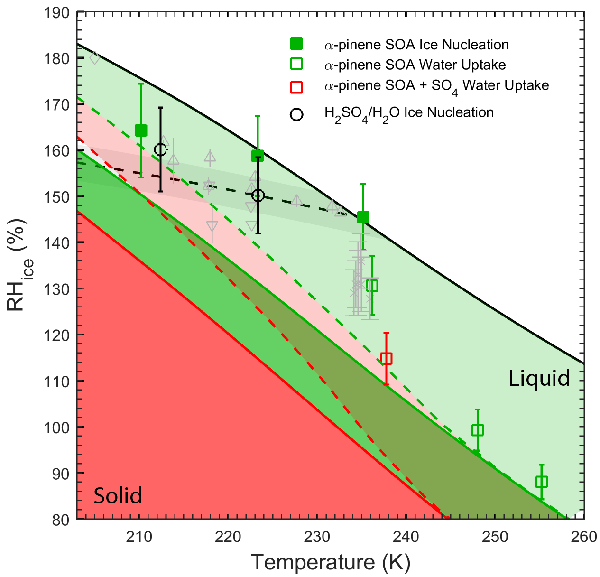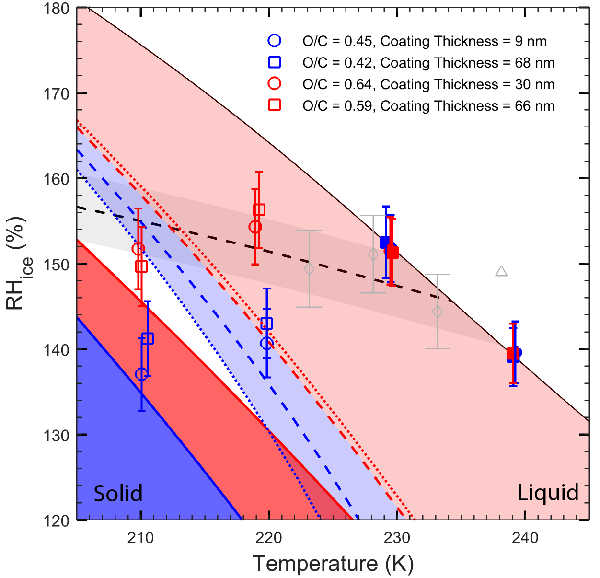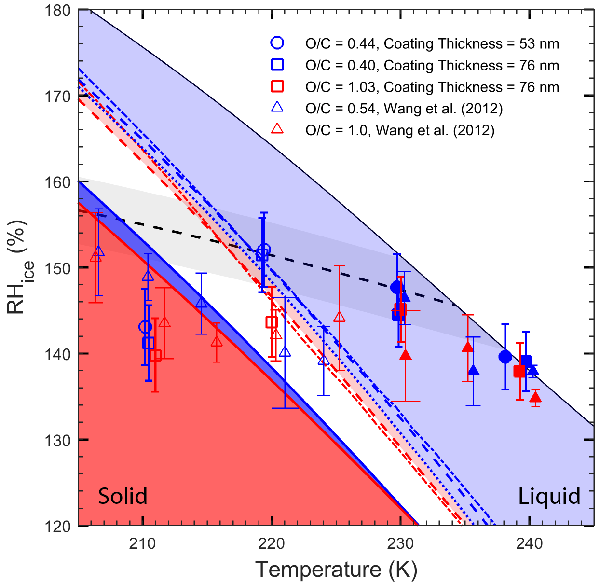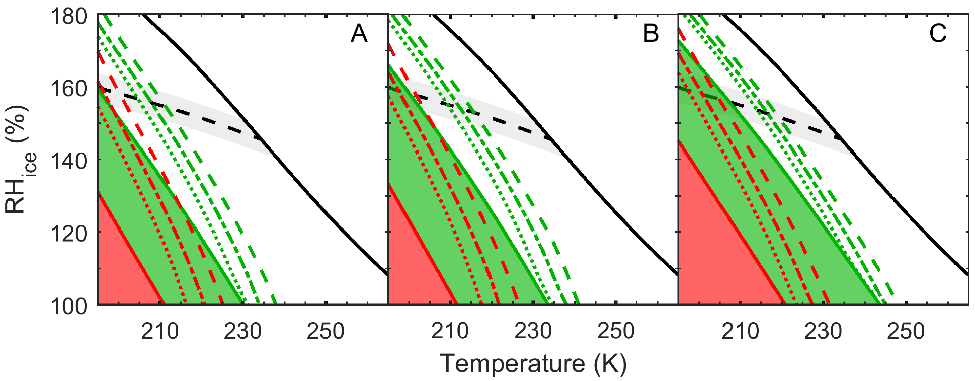
Additions and corrections
Condensed-phase biogenic–anthropogenic interactions with implications for cold cloud formation
Joseph C. Charnawskas, Peter A. Alpert, Andrew T. Lambe, Thomas Berkemeier, Rachel E. O’Brien, Paola Massoli, Timothy B. Onasch, Manabu Shiraiwa, Ryan C. Moffet, Mary K. Gilles, Paul Davidovits, Douglas R. Worsnop and Daniel A. Knopf*
Faraday Discuss., 2017, DOI: 10.1039/C7FD00010C. Amendment published 11th October 2017.
In the manuscript, the full deliquescence relative humidity (FDRH) values returned by the kinetic diffusion model were erroneously plotted against the initial temperatures of each simulation run and not against the temperatures at which full deliquescence actually occurred. Hence, since temperatures decrease upon humidification by a few Kelvin prior to deliquescence, the plotted FDRH values are consistently too high.
This affects Fig. 5–8 and, in instances, associated text. It does not impact the findings and conclusions of the article and the associated Faraday Discussion.
Corrected Fig. 5:

No changes to the figure caption are needed.
Text changes:
On page 180, line 8 from top: Change “Except for the freezing points at the lowest observed temperature, all freezing and water uptake occurs at RHice above FDRH, corroborating the numerical diffusion model.”
To: “All freezing and water uptake occur at RHice above FDRH, corroborating the numerical diffusion model.”
Corrected Fig. 6:

No changes to the figure caption are needed.
Text changes:
On page 181, line 7 from bottom: “(i.e. Tp > ~232 K, RHice = 120%, Fig. 6).” should be changed to “(i.e. Tp > ~228 K, RHice = 120%, Fig. 6).”
On page 181, line 3 from bottom: Change “At 220 K the SOA coated soot particles with O/C ~0.4 formed ice at, or slightly below, RHice of the respective FDRH lines while SOA coated soot particles with O/C ~0.6 formed ice at RHice only above expected FDRH. This suggests that soot particles coated with less-oxidized α-pinene SOA nucleated ice while in a semisolid state, while soot particles coated with more oxidized α-pinene SOA formed ice while in a more liquid-like phase. Although the model suggests that ice formation proceeded from both semisolid and liquid particles, i.e. the particles acquired water, the data are categorized as deposition ice nucleation.”
To: “At 220 K the SOA coated soot particles with O/C ~0.4 formed ice slightly above RHice of the respective FDRH lines and SOA coated soot particles with O/C ~0.6 formed ice at RHice significantly above expected FDRH. This suggests that SOA coated soot particles formed ice while in a more liquid-like phase. Although the model suggests that ice formation proceeded from liquid particles, i.e. the particles acquired water, the data are categorized as deposition ice nucleation.”
Corrected Fig. 7:

No changes to the figure caption are needed.
Text changes:
On page 181, line 8 from bottom: Change “At 220 K, the particles nucleated ice at RHice above their respective Tg and below their FDRH, which indicates that the SOA coating existed in a semisolid state, allowing for heterogeneous ice nucleation. This may rule out the apparent homogeneous nucleation process of SOA coated particles with a medium O/C at RHice ≈ 154%. The potential presence of semisolid organic material in these SOA coated particles with a high and medium O/C at ~220 K may imply the negligible influence of the soot core acting as IN.”
To: “At 220 K, the particles nucleated ice at RHice above their respective Tg and at or slightly below their FDRH for SOA of medium O/C and high O/C, respectively. This indicates that these two types of SOA coating existed in a liquid and semisolid state, respectively, which may have allowed for heterogeneous ice nucleation by the soot core in the first case and the SOA coating in the latter case. Homogeneous nucleation of SOA coated soot particles with a medium O/C at RHice ≈ 154%, however, cannot be ruled out. The potential presence of semisolid organic material in SOA coated particles with a high O/C at ~220 K may imply the negligible influence of the soot core acting as IN.”
Corrected Fig. 8:

No changes to the figure caption are needed.
The Royal Society of Chemistry apologises for these errors and any consequent inconvenience to authors and readers.
Back to article